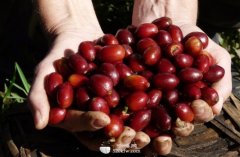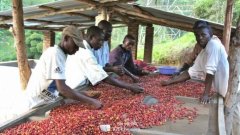Boutique coffee beans introduction to Jamaican Blue Mountain Coffee

Blue Mountain Coffee is recognized as the best in the world because of its unique growing environment and the strict management of the Jamaican government.
The Blue Mountains are located in the eastern part of the island of Jamaica, surrounded by the Caribbean Sea. Whenever the weather is clear, the sun shines directly on the blue sea, and the peaks reflect the bright blue light of the sea, hence the name. The highest peak of the Blue Mountains, which is 2256 meters above sea level, is the highest peak in the Caribbean and a famous tourist attraction. It has suitable temperature, fertile volcanic soil, fresh air, no pollution, humid climate, foggy and rainy all the year round, which provides a perfect environment for the growth of coffee and creates the unparalleled flavor of Blue Mountain Coffee.
In history, due to the lack of quality standards, the export quality of Blue Mountain coffee was uneven, which greatly affected its international reputation. Until 1943, Canada, a big importer of Blue Mountain coffee, refused to import Blue Mountain coffee. In order to improve the quality of coffee, the Jamaican government has taken a series of measures to regulate the coffee industry and established the Jamaican Coffee Industry Committee CIB (the Jamaica Coffee Industry Board) in 1948. The committee sets quality standards for Jamaican coffee and oversees their implementation. Each batch of exported Blue Mountain coffee beans will be sampled and tested by quality supervision experts, and only those coffee beans that meet the standard can obtain the quality recognition certificate issued by the Coffee Industry Committee of Jamaica.
There are three main types of Jamaican coffee:
Blue Mountain Coffee (Blue Mountain Coffee)
Alpine Top Coffee (Jamaica High Mountain Supreme Coffee Beans)
Premium Jamaican Coffee (Jamaica Prime washed)
The Jamaican government has a very strict definition of Blue Mountain Coffee:
Coffee must be grown in the Blue Mountain area designated by the Jamaican Coffee Board, processed by a government-authorized processing plant and certified by the government. Among them, the Blue Mountains are defined as more than ten specific areas, mainly distributed in John Crow, St.John's Peak, Mossman's Peak, High Peak, Blue Mountian Peak and other five peaks. At present, there are only six government-designated Blue Mountain Coffee processing (roasting) plants: WALLENFORD, Mafis River Embankment Central Factory (M.B.C.E), Blue Mountain Coffee Cooperative Plant (M.H.C.C.T.), Portland Blue Mountain Coffee Co-operative Plant (P.X.X.S.H.), St. John's Peak (St.John's Peak) and J.A.S.
Blue mountain coffee export grades: No.1, No.2, No.3, round beans (Peaberry).
Grading criteria:
No.1-17hammer 18 eyes, the proportion of defective beans is not more than 2%
No.2-16ax 17 mesh, the proportion of defective beans is not more than 2%
No.3-15ax 16 mesh, the proportion of defective beans is not more than 2%
Round beans (Peaberry)-10MS, the proportion of defective beans does not exceed 2%
Note: coffee usually grown between 457m and 1524 m above sea level is called Alpine Top Coffee, and coffee grown between 274m and 457m above sea level is called premium water washing in Jamaica. Jamaican coffee was first grown in the hills near Saint Andrew and then gradually expanded to the Blue Mountain area. St. Angel District is still the main coffee production area in Jamaica except Blue Mountain, the coffee produced is similar to Blue Mountain, and the quality is also quite high, but because it is not on the Blue Mountain, it is named by Jamaican High quality Water washing (Jamaica Prime washed), its taste is rich and mellow, sweet, sour and bitter balanced and round, the price on the market is quite high, and it is recognized as one of the best products.
All aspects of the production of Blue Mountain Coffee are strictly managed.
Coffee trees are mainly small-grained "Geisha High Bred" type, using mixed planting method, the seedlings are cultivated in the nursery for about 2 years, and organic fertilizers are used during the growth period. The annual harvest period is from June to November, and coffee trees are picked by hand on the rugged hillsides. The picking process is so difficult that non-local skilled female workers are simply unable to do it. It is very important to choose the right mature coffee beans when picking. Immaturity or ripeness will affect the quality of the coffee. The picked coffee beans are shelled on the same day, and then let them ferment for 18 hours. After that, the coffee beans were cleaned and screened. The subsequent process is to dry, which must be carried out on the cement floor or on a thick blanket until the humidity of the coffee beans drops to 12% 14%. And then store it in a special warehouse. In the process of raw bean processing, there is a special person responsible for quality supervision in each step. For the very precious Blue Mountain Coffee, the packing and transportation mode adopted by the Jamaican government is also different. Unlike other coffees, Blue Mountain Coffee is not packed and transported in cloth bags at 60kg / bag, but in wooden barrels at the standard of 70kg / barrel. Jamaica is also the last country to still transport coffee in traditional wooden barrels.
The pictures are as follows:
1: packaging of blue mountain beans
2: blue Mountain Coffee Brand
3: LOGO of Lanshan Coffee Industry Bureau
4: sample certificate
5: blue Mountain Coffee and Alpine Coffee trademarks
6: national Map of Jamaica
Important Notice :
前街咖啡 FrontStreet Coffee has moved to new addredd:
FrontStreet Coffee Address: 315,Donghua East Road,GuangZhou
Tel:020 38364473
- Prev

The most common coffee beans grown.
There are about 60 kinds of coffee; however, there are mainly 2 kinds of coffee grown in large commercial areas. Arabica 2. If divided according to the planting area of these two kinds of coffee, Arabica species account for 70% of the world's planting area and Robasta species account for 30%. This shows how important Arabica coffee beans are in the world! so
- Next

Yemeni coffee producing area of Asian coffee producing area
Mocha Mattari early Yemeni coffee was mainly exported from the port of Mocha, so the coffee that was later exported from here was named after Mocha. In Yemeni coffee, Mattari and Sanani are more famous, among which Matari tastes more full-bodied, with strong acidity and cocoa flavor, while Sanani has more
Related
- Beginners will see the "Coffee pull flower" guide!
- What is the difference between ice blog purified milk and ordinary milk coffee?
- Why is the Philippines the largest producer of crops in Liberia?
- For coffee extraction, should the fine powder be retained?
- How does extracted espresso fill pressed powder? How much strength does it take to press the powder?
- How to make jasmine cold extract coffee? Is the jasmine + latte good?
- Will this little toy really make the coffee taste better? How does Lily Drip affect coffee extraction?
- Will the action of slapping the filter cup also affect coffee extraction?
- What's the difference between powder-to-water ratio and powder-to-liquid ratio?
- What is the Ethiopian local species? What does it have to do with Heirloom native species?

